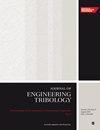管道检测仪用聚氨酯材料的摩擦和磨损动态演变研究
IF 1.6
3区 工程技术
Q3 ENGINEERING, MECHANICAL
Proceedings of the Institution of Mechanical Engineers, Part J: Journal of Engineering Tribology
Pub Date : 2024-08-09
DOI:10.1177/13506501241272798
引用次数: 0
摘要
摩擦和磨损的动态演变会导致界面失效,并引起管道检测仪的振动。在 0.042 至 0.07 兆帕的条件下,对聚氨酯和 X70 钢环形面接触的摩擦行为进行了评估。使用红外摄像机记录了温度的升高。使用 Abaqus 软件对摩擦热和应力应变进行了动态模拟。结果表明,在 0.056 MPa 的初始阶段,内环区域出现了磨料磨损、应力(1.5 MPa)和聚氨酯摩擦温升(65 °C)。由于磨料磨损,聚氨酯的表面粗糙度(3.394 μm)变得与钢环的表面粗糙度(3.768 μm)相当。在后期阶段,外圈的摩擦温度升高(80 °C),应力增加(3.8 兆帕)。同时,外圈出现了表明粘滑行为的沙拉马赫波和脊状条纹。粘弹性滞后效应是摩擦系数和磨损动态演变的根本原因。摩擦热加剧了粘滑行为的演变,并增加了摩擦系数的波动。本研究的结果可用于分析管道检测规中界面失效和振动的原因。本文章由计算机程序翻译,如有差异,请以英文原文为准。
Study on the dynamic evolution of friction and wear of polyurethane material for pipeline inspection gauge
The dynamic evolution in friction and wear can lead to interface failure and induce vibrations in pipeline inspection gauge. The friction behavior between polyurethane and X70 steel was evaluated with annular face contact under 0.042 to 0.07 MPa. The temperature increase was recorded using infrared cameras. Dynamic simulations of frictional heat and stress-strain were conducted using Abaqus software. The results indicate that in the initial stages, abrasive wear, stress (1.5 MPa), and frictional temperature rise (65 °C) of PU were observed in the inner-ring region at 0.056 MPa. The surface roughness (3.394 μm) of the PU became comparable to that of the steel ring (3.768 μm) due to abrasive wear. In the later stages, a higher frictional temperature (80 °C) and increased stress (3.8 MPa) were observed in the outer ring. Concurrently, Schallamach waves and ridge-like stripes indicative of stick-slip behavior emerged in the outer ring. The viscoelastic hysteresis effect is the fundamental cause of the dynamic evolution of the friction coefficient and wear. Frictional heat exacerbates the evolution of stick-slip behavior and increases fluctuations in the friction coefficient. The findings of this research can be utilized to analyze the causes of interface failure and vibration in pipeline inspection gauge.
求助全文
通过发布文献求助,成功后即可免费获取论文全文。
去求助
来源期刊

CiteScore
4.20
自引率
5.00%
发文量
110
审稿时长
6.1 months
期刊介绍:
The Journal of Engineering Tribology publishes high-quality, peer-reviewed papers from academia and industry worldwide on the engineering science associated with tribology and its applications.
"I am proud to say that I have been part of the tribology research community for almost 20 years. That community has always seemed to me to be highly active, progressive, and closely knit. The conferences are well attended and are characterised by a warmth and friendliness that transcends national boundaries. I see Part J as being an important part of that community, giving us an outlet to publish and promote our scholarly activities. I very much look forward to my term of office as editor of your Journal. I hope you will continue to submit papers, help out with reviewing, and most importantly to read and talk about the work you will find there." Professor Rob Dwyer-Joyce, Sheffield University, UK
This journal is a member of the Committee on Publication Ethics (COPE).
 求助内容:
求助内容: 应助结果提醒方式:
应助结果提醒方式:


